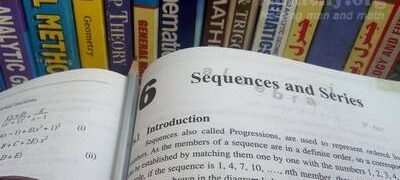
Chapter 06: Sequences and Series
Sequences and series are fundamental concepts in mathematics that deal with the ordered arrangement of numbers. A sequence is a list of numbers arranged in a particular order, while a series is the sum of the terms of a sequence.
A sequence can be finite or infinite. In a finite sequence, there is a specific last term, while in an infinite sequence, the terms continue indefinitely. Each term in a sequence is typically denoted by an index, usually a positive integer.
Sequences can be defined in different ways. They can be explicitly defined by providing a formula or rule to generate each term. For example, the sequence 1, 4, 7, 10, 13, … can be defined explicitly as the arithmetic sequence with a first term of 1 and a common difference of 3. The nth term of this sequence can be found using the formula an = a1 + (n – 1)d, where a1 is the first term, d is the common difference, and n is the index of the term.
Sequences can also be defined recursively, where each term is defined in terms of the previous terms. For example, the Fibonacci sequence starts with 0 and 1, and each subsequent term is the sum of the two preceding terms: 0, 1, 1, 2, 3, 5, 8, 13, …
Series, on the other hand, involve summing the terms of a sequence. A series is represented by adding the terms of a sequence using the sigma (∑) notation. For example, the series 1 + 2 + 3 + 4 + … can be represented as ∑(n = 1 to ∞) n. The sum of an infinite series may or may not converge to a finite value.
Different types of series can be classified based on their properties. Some common types include arithmetic series, geometric series, and harmonic series. Each type has its own specific pattern of terms and sum formulas.
Sequences and series find applications in various areas of mathematics, science, engineering, and finance. They are used to model and analyze patterns, calculate sums, approximate functions, solve equations, and more. The study of sequences and series provides a deeper understanding of mathematical structures and their real-world implications.
Contents & summary
- Introduction
- Types of Sequences
- Exercise 6.1
- Arithmetic Progression(A.P)
- Exercise 6.2
- Aritmetic Mean (A.M)
- n Arithmetic Means between two given Numbers
- Exercise 6.3
- Series
- Exercise 6.4
- World Problems on A.P.
- Exercise 6.5
- Geometric Progression(G.P)
- Exercise 6.6
- Geometric Means
- n Geometric Means between two given numbers
- Exercise 6.7
- Sum of n terms of a Geometric Series
- The Infinite Geometric Series
- Exercise 6.8
- World Problems on G.P.
- Exercise 6.9
- Harmonic Progression(H.P)
- Harmonic Means
- n Harmonic Means between two numbers
- Relation between Arithmic, Geometric and Harmonic Means
- Exercise 6.10
- Sigma Notation(or Summation Notation)
- To find the Formulae of Sum
- Exercise 6.11

